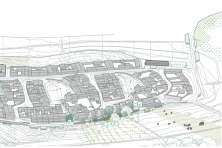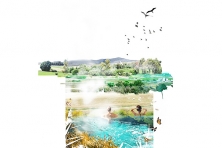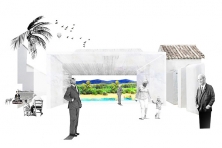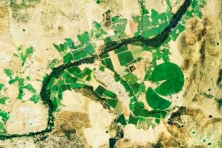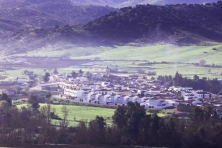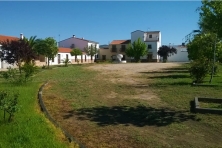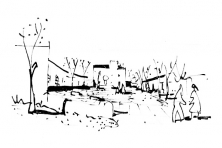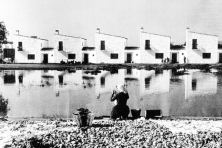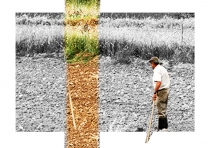BAZANA GO!
La Bazana (ES) - Lauréat
DONNÉES DE L’ÉQUIPE
Représentante d’équipe : Virginia de Jorge (ES) – architecte
Associé: Nicolás Gutiérrez (ES) – architecte
Collaborateurs: Berta Calle (ES) – étudiante en architecture; Jaime Cored (ES), Marta Monzón (ES) – ingénieurs en batiment
Calle Ávila 49, 28804 Alcalá de Henares, Madrid (ES)
+34 656541035 – bazanago@gmail.com – bazanago.wordpress.com
Voir la liste complète des portraits ici
Voir la page du site ici

V. de Jorge et N. Gutiérrez
INTERVIEW en anglais
Cliquer sur les images pour les agrandir
1. How did you form the team for the competition?
We know each other from the ETSA-UAH (School of Architecture, Universidad de Alcalá) as we were both students. Virginia de Jorge-Huertas (Madrid, 1991) is an Architect graduated from the School of Architecture of the UAH, and Nicolas Gutierrez is an Advanced Project Master also at the UAH, and we are currently PhD students. La Bazana offered us the opportunity to respond to a national problem, the depopulation and disconnection in rural areas. We thought it was the ideal place and time to propose, in a professional framework, a model of sustainability and viability to improve this situ-action.
2. How do you define the main issue of your project, and how did you answer on this session main topic: the place of productive activities within the city?
The proposal is implemented on the basis of a ‘Master Plan’, and is financed autonomously, through the population's natural resources management. Therefore, our proposal is gradually built in a long-term basis, thought-provoking process and is governed by the following principles of the needs of the agricultural cooperative (machinery installation, industry, room, temporary residence, etc.). This set of interventions requires, by restoration and recovery of existing buildings and the construction and repair of existing buildings by collaborative association. Or future new building if require. Cross-cutting, we have proposed small ‘surgical interventions’ of urban rehabilitation that seek to recover the original approaches of Alejandro De la Sota project (1954) by means of a continuous micro actuation system. In particular, we have the landscape from the different squares that are located in the centre of the city and configure the population through "windows to the landscape" or vantage points framing the city and enhancing the identity and view of the place. Also, it aims at restoring the original configuration and their materiality, enabling these spaces to take on new responsibilities in a new way, such as atmospheres and socio-urban proposals. Associated with these new viewpoints, we are proposing the recovery of an old sprinkling canal, an irrigation ditch on the edge of the river, delimiting the population towards the valley and limiting urban growth through it. With this, and through its formal transformation, we configure a new urban border as a continuous perimeter made up of natural pools purified by slow phyto-purification processes.
The key point is recovering the relationship between nature and society, by making a take-care and productive symbiosis, promoting the intermediate spaces generated between the landscape, the square and the courtyard, opening a new differential and reference space associated with the enjoyment of being rural environment, thus promoting a model of survival, stable and sustainable.
3. How did this issue and the questions raised by the site mutation meet?
The colonization towns were built with the intention of resolving a territorial problem in a post-war context. An individualistic survival model was implemented for the development of new families: subsistence agriculture. This model has been preserved to this day, without adapting to changes in forms and lifestyles. This is why our project proposes an update of this model, adapting it to the new times and lifestyles and to the new ecological and sustainable trends that, from a long time ago, have captured the consumers' awareness of European and international markets. In order to carry it out, we drew up a 'Master Plan' in which we have worked with different variables (efficient agriculture and livestock management, acquisition of machinery, strengthening of the existing architecture, construction of new buildings and urban rehabilitation, etc.) and this has allowed us to measure the employment of new workers, which we have estimated at 150 jobs in 14 years. Furthermore, it is essential for us to offer women a job opportunity in the rural context, and our project is based on this occupation.
4. Have you treated this issue previously? What were the reference projects that inspired yours?
We are really interested in this topic from different points of view, from cooperative collaborative housing to agricultural cooperative approaches but also from the rural to the urban environment. Our research studies in our respective PhD are related to the issue given by Europan from multidisciplinary focus. In fact, one of our doctoral thesis treats about the transhumance (livestock migration) and its capacity to structure the territory and the other PhD is focusing on alternative housing approaches, related to collaborative and cooperative management in experimental domestic infrastructures as far as the "thresholds spaces" in the in-betweens. Fundamentally there are key references to La Bazana project: Alejandro de la Sota original project in 1954 to the “hidden town” and elastic streets, permeable common space and squares related to the landscape.
5. Urban-architectural projects like the ones in Europan can only be implemented together with the actors through a negotiated process and in time. How did you consider this issue in your project?
The participative process (De Carlo, 1970) through time is a key point in our proposal as we thought in the collaborative approach as a negotiated process in time, which can only be implemented and developed in the whole process together with the tenants, citizens, users and agents involved in the project to reach an holistic approach. It is also the reason of our title: “BAZANA GO! Ecological agricultural cooperative”. A cooperative as the basis and strength of the project.
6. Is it the first time you have been awarded a prize at Europan? How could this help you in your professional career?
This first prize has been the first time for us, so we are very proud since Europan is the most relevant prize in the young European context and, for this reason, it has been a real important impulse and recognition of and for our work. As students and professionals, Europan has been a fundamental part of our training. In fact, the biennial publications of the prize-winning works have been and still are essential parts of our main bibliographical references. This prize promotes young Architects ideas as well as the impressive impulse and development of their early careers.
